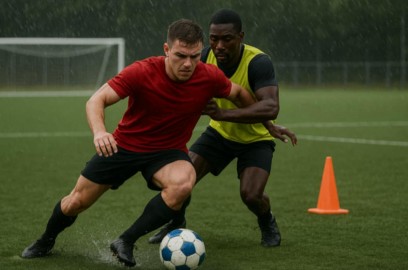
In modern football, every player – regardless of whether they play in attack, midfield, or defense – must be able to defend. Effective defensive play is not just about tackles, but about positioning, focus, and teamwork. Here are 7 practical tips and exercises that will help you raise your defensive level no matter what position you play.
-
BODY POSITIONING – ALWAYS BETWEEN THE OPPONENT AND THE GOAL
Your body should block the shortest route to the goal. This forces the opponent into less dangerous areas.
How to train:
-
1v1 drills – set up against an opponent with the ball and practice keeping the right defensive angle. A coach or partner can signal a change of direction, and your job is to adjust your position quickly.
-
Mirror drills – player A moves side-to-side or forward/backward, and player B mirrors the movement, keeping the correct distance and staying between the opponent and the goal.
-
READING THE GAME AND ANTICIPATING OPPONENT’S MOVES
Watch the opponent’s hips, first touch, and line of sight for clues.
How to train:
-
Video analysis – watch matches and pause in key moments, predicting what the player with the ball will do next.
-
“First touch reading” drill – a partner passes the ball to an attacker, and your task is to react instantly to the direction of their first touch.
-
APPLYING PRESSURE AT THE RIGHT MOMENT
First, slow down the opponent and close down space before attempting to win the ball.
How to train:
-
1v1 in a small grid – the attacker tries to dribble past you in a tight area. Your task is patience and timing the tackle correctly.
-
Timed defense – the attacker has 5 seconds to beat you, and your job is to delay them until the time runs out.
-
COMMUNICATION WITH THE TEAM
Defense is collective work.
How to train:
-
Small-sided games (e.g., 4v4 + goalkeepers), where an additional rule is that players must communicate loudly before passing.
-
“Line captain” drill – one defender is responsible for organizing the back line and giving clear commands, which teaches leadership and responsibility in defense.
-
TACTICAL DISCIPLINE
The key is responsibility and maintaining formation.
How to train:
-
Team shifting exercises – the coach moves the ball to different zones of the pitch, and the defensive line or team must shift together, keeping correct spacing.
-
7v7 game with conditions – for example, defenders cannot push higher than a marked zone, training positional awareness.
-
PHYSICALITY AND ENDURANCE
Without fitness, you cannot stay sharp for 90 minutes.
How to train:
-
Recovery sprints – sprint to the ball, stop, turn, and sprint back at maximum speed to mimic counterattack situations.
-
Defender intervals – for example, 30 seconds sprint, 30 seconds jog, repeated for 10 minutes.
-
Strength training – squats, lunges, core work, and stability exercises.
-
WARRIOR MENTALITY – FOCUS AND DETERMINATION
You must want to win every duel and every meter of the pitch.
How to train:
-
50/50 challenge – two players sprint toward a loose ball; the aim is to fight and win the duel.
-
Training under pressure – limit reaction time (e.g., coach gives a sudden signal and plays the ball, you must react instantly).
-
Mental training – visualization of defensive duels, focusing on keeping a winning mindset.
SUMMARY
Any player can improve defensively by combining knowledge with practice. Add these drills to your training routine and you’ll quickly see progress – not only will you defend better, but you’ll also become a more complete player, the kind of professional clubs are looking for.





